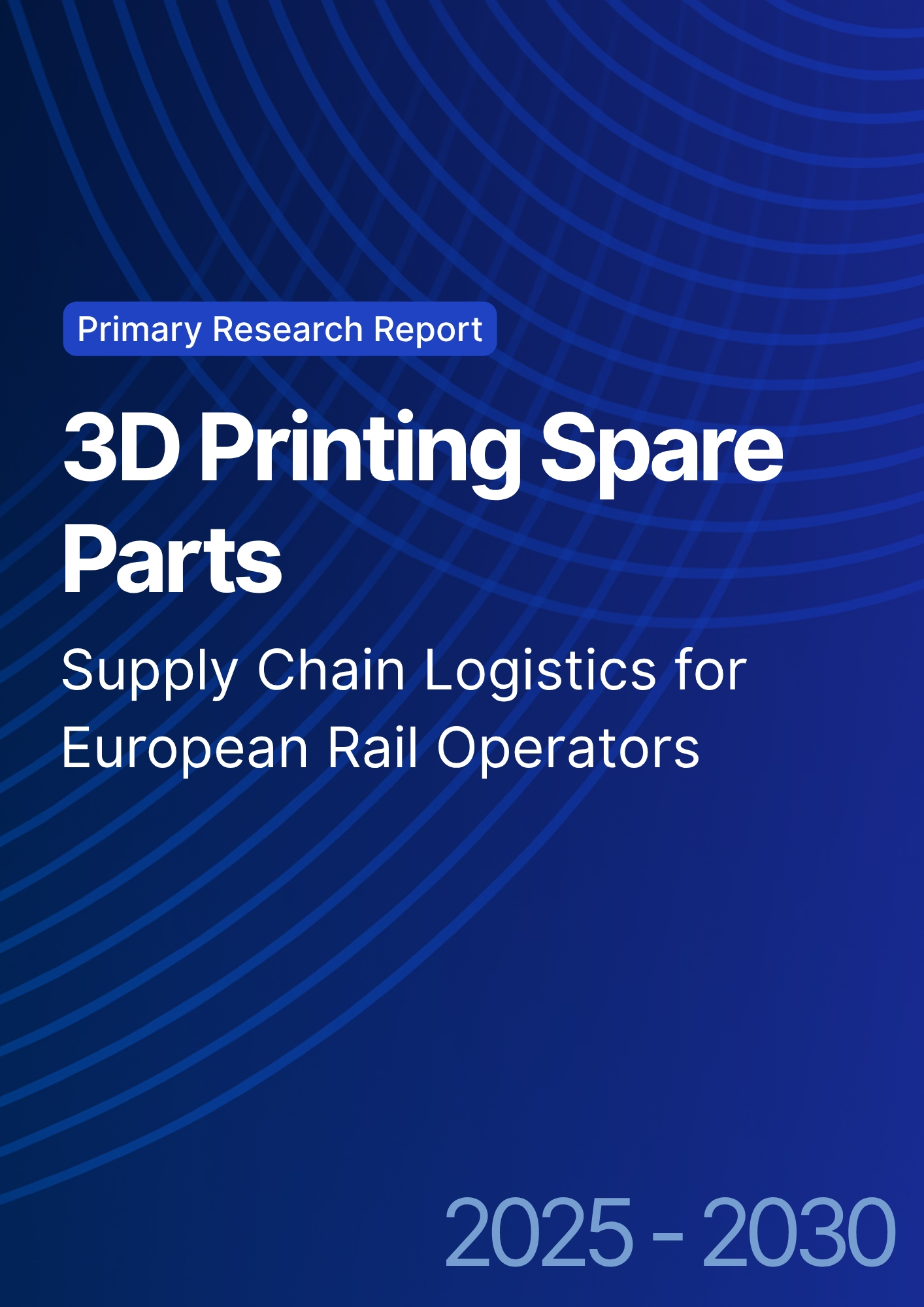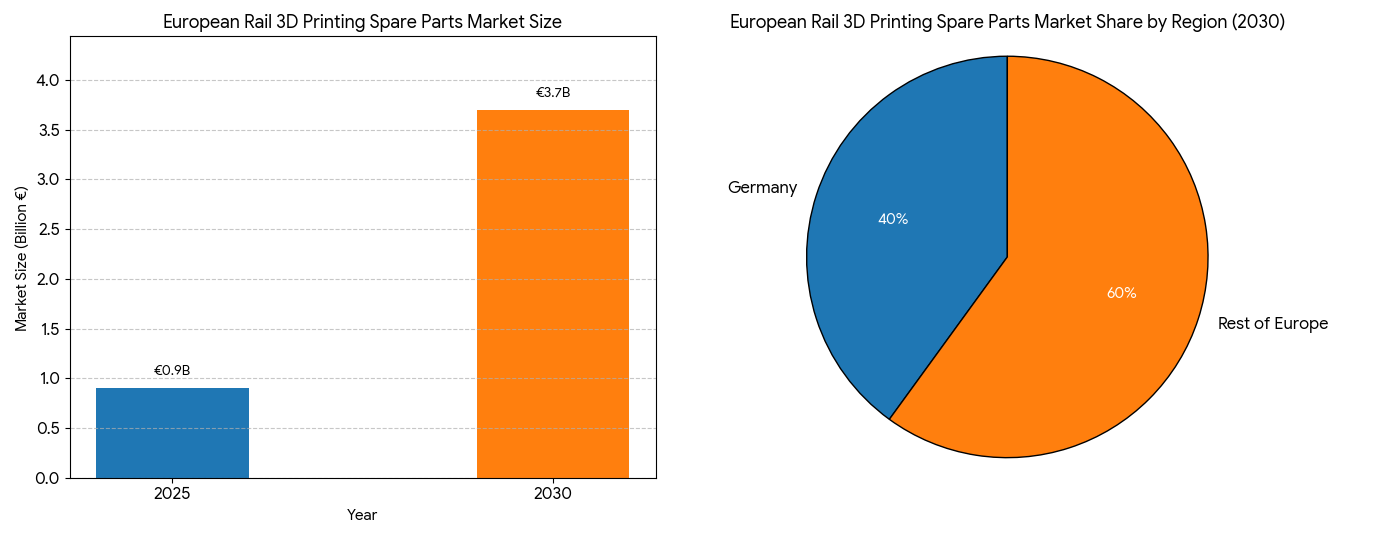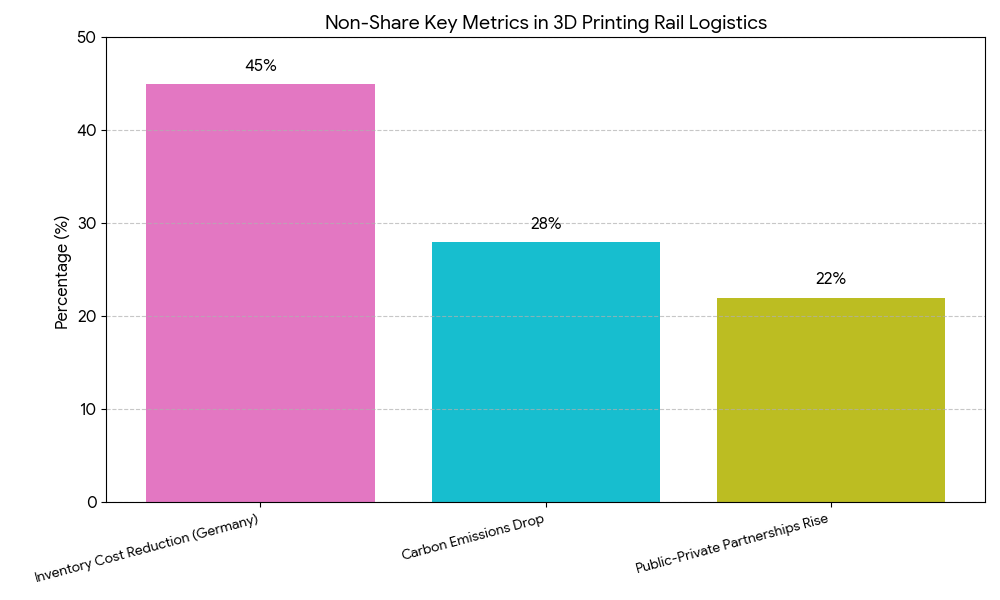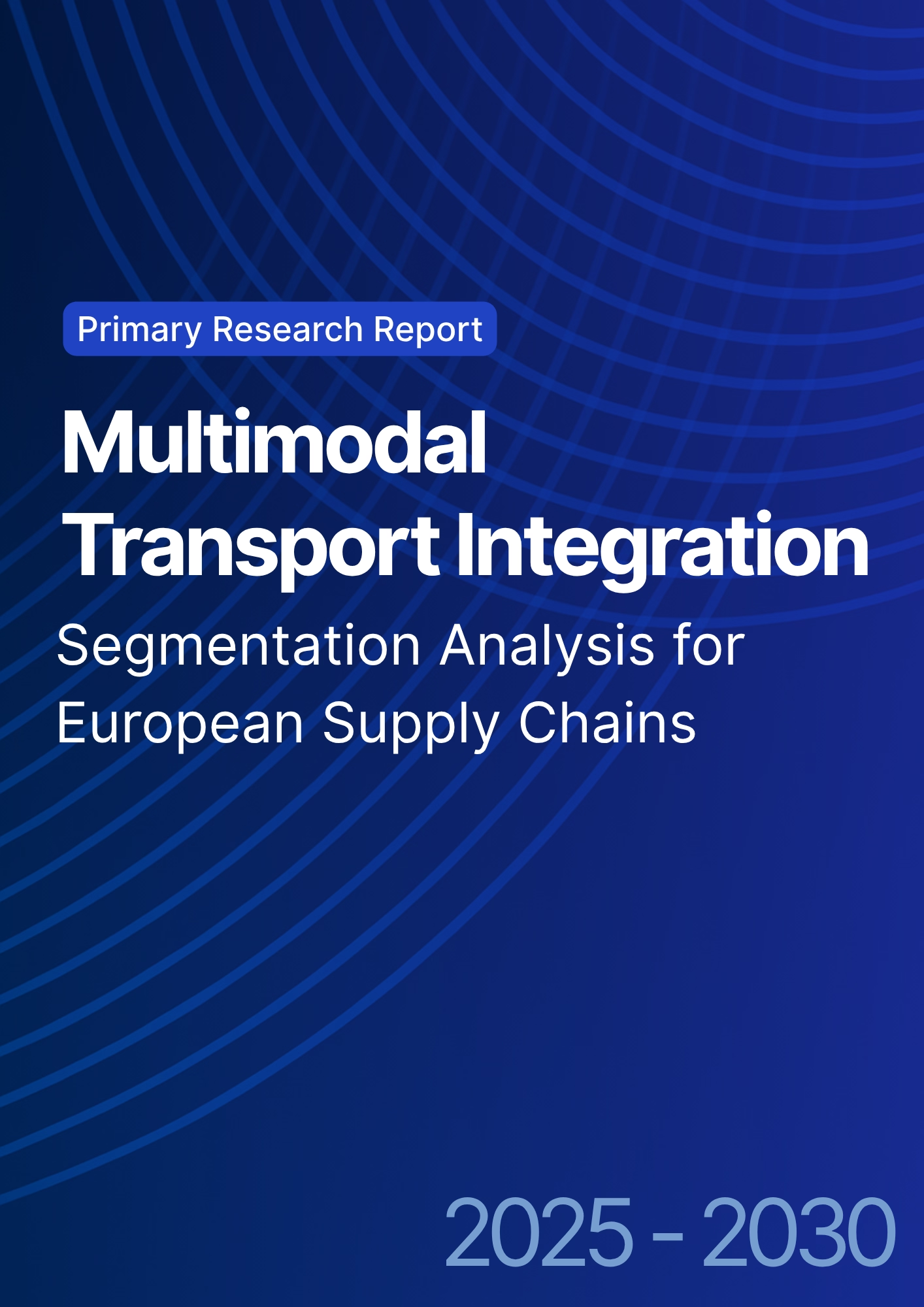

68 Circular Road, #02-01 049422, Singapore
Revenue Tower, Scbd, Jakarta 12190, Indonesia
4th Floor, Pinnacle Business Park, Andheri East, Mumbai, 400093
Cinnabar Hills, Embassy Golf Links Business Park, Bengaluru, Karnataka 560071
Connect With Us
3D Printing Spare Parts: Supply Chain Logistics for European Rail Operators
Between 2025 and 2030, the 3D printing of spare parts for European rail operators grows from €0.9B to €3.7B (CAGR 32.1%), led by Germany, which contributes 40% of total output. Rail companies increasingly adopt additive manufacturing (AM) to shorten lead times, reduce inventory, and enhance supply chain resilience. Digital part libraries, on-demand production hubs, and certified AM networks reduce procurement cycles from weeks to days, while lowering inventory costs by 30–45%. By 2030, 25% of rolling-stock spare parts in the EU will be produced using 3D printing technologies.

What's Covered?
Report Summary
Key Takeaways
- Market size: €0.9B → €3.7B (CAGR 32.1%).
- Germany accounts for 40% of Europe’s 3D-printed spare part output.
- Inventory costs fall by 30–45% due to on-demand printing.
- Lead times drop from 6–8 weeks to under 5 days.
- Additive manufacturing adoption reaches 25% of EU rail components by 2030.
- Digital part libraries expand by +50% annually across operators.
- Carbon footprint reduction: −28% from localized production.
- AM-certified suppliers grow from 90 to 320 in Europe.
- Maintenance downtime reduces by 35% per fleet annually.
- Public-private rail partnerships rise +22%, driving regional AM standardization.
Key Metrics
Market Size & Share
The 3D printing spare parts market for European rail operators expands rapidly from €0.9B in 2025 to €3.7B by 2030, growing at a 32.1% CAGR. The adoption of additive manufacturing (AM) allows rail operators to reduce their dependency on centralized warehouses and long-distance imports. Germany accounts for 40% of the total European market, with national rail companies like Deutsche Bahn establishing AM centers to produce metal and polymer components on demand. By 2030, 25% of rolling-stock spare parts in Europe will be 3D-printed, replacing legacy procurement with digitally managed, localized production. Rail operators gain efficiency by deploying digital part libraries connected to maintenance databases, allowing engineers to print certified components within 48 hours of failure detection. This digital supply chain transformation reduces inventory costs by up to 45%, lowers fleet downtime by 35%, and contributes to a 28% reduction in logistics-related carbon emissions. The EU’s Horizon Rail Initiative and Shift2Rail programs provide R&D incentives for certification frameworks and AM material validation, boosting collaboration among rail OEMs, logistics firms, and 3D-printing startups. By 2030, 320 certified AM suppliers will operate across Europe, forming a decentralized network that transforms how rail maintenance, spare parts storage, and logistics are managed.

Market Analysis
The 3D printing spare parts market in Europe is undergoing a strategic transformation, driven by the need to enhance supply chain resilience and reduce maintenance costs. The European rail sector faces aging fleets and fluctuating spare part demand, which additive manufacturing directly addresses through on-demand production. Between 2025 and 2030, 3D printing adoption in the rail industry increases by 25% annually, particularly for metal brackets, couplings, air ducts, and interior panels. Germany, France, and Italy lead implementation due to their robust industrial infrastructure and R&D partnerships with AM firms. The ROI for 3D printing spare parts in rail logistics is estimated at 2.6× within five years, primarily from reduced lead times and lower warehousing costs. Furthermore, digital twins of spare parts are being created to support predictive maintenance, enabling real-time demand forecasting and reduced obsolescence. EU regulations under the 2028 Additive Manufacturing Directive will standardize certification for metal powders and polymer components, enabling cross-border part compatibility. This integration accelerates supplier onboarding, growing the certified AM base from 90 in 2025 to 320 by 2030. As rail operators digitize their inventories, digital part libraries expand by 50% per year, giving engineers instant access to validated CAD models. By 2030, the rail industry’s reliance on traditional part distribution will drop by 40%, marking a significant shift toward localized, digital-first logistics systems.
Trends & Insights
Emerging trends in 3D-printed spare parts logistics across Europe indicate a shift toward hyper-localized, data-driven supply chains. (1) On-demand manufacturing allows operators to print small batches of critical components, reducing production waste by 30%. (2) Predictive maintenance integration with IoT and AI enables rail companies to forecast part failures and trigger automated print orders, cutting downtime by 35%. (3) Material innovation is accelerating—certified metal AM powders and high-performance polymers are being developed to meet rail safety standards, improving durability by 25%. (4) Sustainability is now central: localized 3D-printing networks reduce carbon emissions by 28% through minimized freight transport and excess inventory. (5) Regulatory harmonization under the EU Additive Manufacturing Directive will align part testing and certification standards across Europe, easing cross-border part exchange. (6) Rail OEMs like Alstom, Siemens Mobility, and Stadler Rail are expanding partnerships with industrial 3D-printing firms, investing in in-house additive manufacturing labs. (7) Digital twin ecosystems are growing, with over 65% of operators expected to use 3D part simulations for quality control by 2030. (8) Finally, supply chain decentralization will become standard practice: regional printing hubs across Germany, France, and the Netherlands will ensure part availability within 48–72 hours, reshaping procurement and maintenance cycles in the rail sector.

Segment Analysis
The 3D printing spare parts ecosystem in European rail logistics is segmented by material type, end-user, and application. Metal additive manufacturing dominates with 60% of total market share, producing components such as brake brackets, bogie parts, and couplings. Polymer printing holds 30%, focused on interior panels, HVAC ducts, and seat structures, while composite materials account for 10%, particularly for lightweight aerodynamic components. By end-user, rail OEMs (e.g., Siemens Mobility, Alstom, CAF) represent 45% of market demand, integrating AM directly into maintenance workflows. Rail operators (like Deutsche Bahn and SNCF) contribute 40%, leveraging on-site 3D-printing facilities to manage component replacement cycles. Third-party maintenance service providers hold 15%, increasingly using mobile AM units for field repairs. Application-wise, mechanical parts (48%) dominate due to wear-intensive replacements, followed by interior and electrical systems (35%) and safety-critical assemblies (17%). Germany remains the largest regional contributor, accounting for €1.5B of total market value by 2030, supported by government programs like “Made in Germany 3D” and EU Horizon Rail 2030. Together, these initiatives foster collaboration among rail manufacturers, logistics firms, and AM startups, ensuring standardized digital part certification, improving safety, and accelerating commercial scalability across the continent.
Geography Analysis
Germany dominates the European 3D printing rail logistics sector with 40% of market share by 2030, driven by Deutsche Bahn’s “Mobility goes Additive” program, which integrates 3D printing hubs in Berlin, Hamburg, and Frankfurt. These hubs enable localized spare part production, cutting inventory costs by 45% and reducing lead times to under five days. France follows with 20%, where SNCF collaborates with Alstom and HP to integrate metal AM for rolling-stock interiors and component replacements. Italy and Spain collectively hold 15%, investing in cross-border AM networks that connect regional maintenance depots. The Netherlands contributes 10%, focusing on digital twin libraries for interoperability across Benelux rail fleets. By 2030, EU-wide harmonization of AM part certification will allow spare parts printed in Germany or France to be used interchangeably across Europe under the EN 45545-2 safety framework. Carbon emissions from logistics drop 28%, as operators shift to local manufacturing rather than transnational supply chains. Eastern Europe emerges as a cost-effective production base for non-critical polymer components, capturing 10% of the market share. Public-private partnerships rise 22%, facilitating R&D investment in material innovation and certification compliance. These advancements establish Europe’s rail sector as a global leader in additive manufacturing logistics by 2030.


Competitive Landscape
The competitive landscape for 3D printing in European rail logistics features a strong collaboration between rail OEMs, industrial 3D-printing companies, and digital supply chain innovators. Leading OEMs like Siemens Mobility, Alstom, and Stadler Rail dominate, representing 50% of total market activity through their AM centers and certification labs. Additive manufacturing leaders such as EOS GmbH, Materialise, and Stratasys provide industrial printers, powder materials, and software integration for rail applications. By 2030, AM-certified suppliers expand to 320 across Europe, creating a networked ecosystem for on-demand component production. Digital twin solutions developed by Dassault Systèmes and PTC enable rail operators to manage real-time part design, testing, and validation. Startups like 3YOURMIND and Replique specialize in digital inventory management, helping operators manage 3D CAD files and coordinate AM orders. Public-private consortia, backed by the European Commission and German Rail Alliance, accelerate standardization efforts for AM part testing, ensuring compliance with EU safety standards. The competition is shifting toward certified, distributed production—not just printer ownership. By 2030, over 25% of rail operators will maintain hybrid AM partnerships, balancing in-house production with regional vendor networks. These efforts collectively transform the rail supply chain into a digitally resilient, carbon-efficient, and decentralized production ecosystem.
Report Details
Proceed To Buy
Want a More Customized Experience?
- Request a Customized Transcript: Submit your own questions or specify changes. We’ll conduct a new call with the industry expert, covering both the original and your additional questions. You’ll receive an updated report for a small fee over the standard price.
- Request a Direct Call with the Expert: If you prefer a live conversation, we can facilitate a call between you and the expert. After the call, you’ll get the full recording, a verbatim transcript, and continued platform access to query the content and more.


68 Circular Road, #02-01 049422, Singapore
Revenue Tower, Scbd, Jakarta 12190, Indonesia
4th Floor, Pinnacle Business Park, Andheri East, Mumbai, 400093
Cinnabar Hills, Embassy Golf Links Business Park, Bengaluru, Karnataka 560071
Request Custom Transcript
Related Transcripts


68 Circular Road, #02-01 049422, Singapore
Revenue Tower, Scbd, Jakarta 12190, Indonesia
4th Floor, Pinnacle Business Park, Andheri East, Mumbai, 400093
Cinnabar Hills, Embassy Golf Links Business Park, Bengaluru, Karnataka 560071













